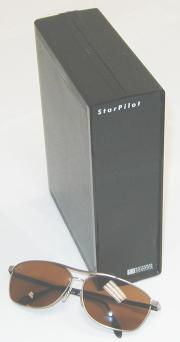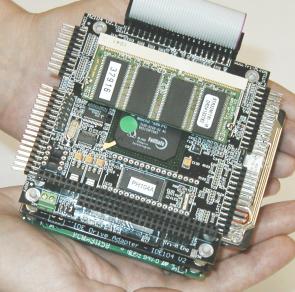Device profile: NSC StarPilot mobile communication platform
Jul 17, 2002 — by LinuxDevices Staff — from the LinuxDevices Archive — 2 viewsNational Scientific Corporation (“NSC”, Scottsdale, Arizona) and its European partner Followit AB have developed locator technology that is a merger of cell phone and global positioning RF systems technologies. Using this technology, small, portable devices can be placed in a vehicle or on a person for use in tracking or locating assets or people in more than 120 countries around the world. The first version of this product was called Followit, a matchbox-sized battery-operated technology that utilizes the global positioning satellite system by identifying precise location using satellite signal triangulation and reporting the longitude and latitude via cellular phone to a remote computer on the internet, which graphically displays the device's location.
 The recently announced StarPilot is the first product in NSC's StarSeries line of intelligent wireless communication platforms for automotive environments. Unlike Followit, whose only propose is to provide location information remotely, the StarSeries devices are general purpose mobile computing platforms that can also offer location-based information services. The StarSeries products are based on an embedded PC/104-based Linux computer with location information servers that are designed to connect the car's onboard systems, and its occupants, to a broad spectrum of wireless data services. The compact (9 x 3 x 7 in.) can be mounted discretely in the trunk or under one of the vehicle's front seats.
The recently announced StarPilot is the first product in NSC's StarSeries line of intelligent wireless communication platforms for automotive environments. Unlike Followit, whose only propose is to provide location information remotely, the StarSeries devices are general purpose mobile computing platforms that can also offer location-based information services. The StarSeries products are based on an embedded PC/104-based Linux computer with location information servers that are designed to connect the car's onboard systems, and its occupants, to a broad spectrum of wireless data services. The compact (9 x 3 x 7 in.) can be mounted discretely in the trunk or under one of the vehicle's front seats.
According to NSC V.P. of Technology Applications and Sales, Graham Clark, “the StarPilot enhances users' personal safety in addition to providing vehicle protection and theft recovery support. It does this by allowing any authorized person to accurately locate that vehicle on a web-based map using a normal web browser. The unit can perform this task without the high monthly fees common to other products that can perform this function. It can also perform this task without engaging law enforcement, a requirement of the now somewhat dated Lo-Jack device.”
“But StarPilot is much more than a remote location tool,” Clark added. “StarPilot's GPS system provides data that can be displayed on any PDA with appropriate software to provide complete in car navigation support.” This allows the driver to see the car's progress on a 'moving map' display as it travels towards its destination and provide turn-by-turn route information. The base model of the StarPilot can also provide GeoFencing support, remotely notifying anyone that a vehicle has left a certain pre-defined area. A parent might use this feature, for example, to keep a teenage driver from venturing too far from home without permission, or driving too fast. The system can also keep a running log of a vehicle's stops and starts, and this log could be set to last for years, if necessary, given the large storage space on the StarPilot's drive.”
The base configuration of StarSeries includes a trunk-mounted GPS/GSM StarPilot unit, one year's worth of SMS location service, remote location capabilities via internet, simple navigation assistance, parental remote car control with location and speed alerts, travel route logging, and basic theft recovery support.
Developer friendly
Perhaps the most exciting aspect of the StarPilot is its flexibility. Since it is a complete embedded Linux computer running in the car — and a modular, expandable PC/104-based one at that — new functions and applications can readily be added to adapt the device to unique requirements and future standards. “The system's architecture can be extended into mobile computing arenas that have not previously been achievable by a single commercial platform in an automotive package,” said Clark.
Clark believes developers will be excited by the StarPilot for a variety of reasons . . .
- Full Linux environment, complete with a plentiful suite of open source development tools
- Modular PC/104 expansion bus, allowing easy extension or customization of the hardware solution with new interfaces, sensing devices, additional memory, and more
- Full support for standards such as PERL, GNU C, C++, Java
- Built-in Apache Web Services
- Commitment to AMI-C compatibility, when specification is formally released
- A company committed to an open source philosophy, free from expensive and awkward Microsoft dependence in its product line
“StarPilot's open software and hardware architecture allows NSC, or third parties, to expand it into new mobile computing arenas that have not previously been achievable by a single commercial platform in an automotive package,” added Clark. Some future extensions for StarPilot are expected to include . . .
- Direct interfacing to the CAN2 bus of the car, allowing download of real-time vehicle performance information
- Automatic synchronization of the StarPilot server to a home or office network via 802.11b network
- MP3 player integration for in-car entertainment
- Arcade games for the kids in the back seat
- In bound fax receipt
- MLS access from the road for Realtors
- USB camera to capture and transmit activity in the vehicle's vicinity
- Web surfing while traveling using GPRS extensions or based on 802.11b synchronized web page downloads
- Full email access from the road, including sending replies
- Vertical market software solutions for vehicle navigation and route finding support, commercial vehicle tracking
- POS solutions for sales, including on-line wireless credit card authorizations
- Long term data logging of vehicle travels for expense reports, and other commercial purposes
Some of these extensions can be performed with additional software only; others will require additional hardware as well. The Company plans to release its own wireless touch screen display for the device in mid to late 2002 called StarPad, although the device functions today with a wide variety of existing display and output solutions from other vendors.
A peek under the StarPilot's hood
Here is a summary of the features, functions, and major internal components of the StarPilot hardware and software . . .
- Embedded computer: Based on 100 MHz ZFx86 x86-compatible system-on-chip processor with Phoenix embedded PC BIOS, 32-64 MB SODIMM SDRAM, and a modular PC/104 architecture (see photo, below)
- GPS receiver: High sensitivity 12-channel GPS receiver with WAAS & EGNOS built-in demodulator and embedded active micro-antenna
- Cellular SMS Transceiver: Nokia GSM module, 1900 MHz, 1W nominal power
- Input/output ports:
- Two RS232 ports (one used for cell phone communication)
- Bi-directional AT-compatible printer port
- USB root hub interface
- Two RS232 ports (one used for cell phone communication)
- Optional expansion interfaces:
- Dual PCMCIA slot adapter (PC/104 module)
- 802.11b PCMCIA Wireless LAN Connect Card
- CAN2 Bus interface
- Dual PCMCIA slot adapter (PC/104 module)
- Mass storage:
- 20 GB internal 2.5-inch bootable IDE disk (on a PC/104 carrier module)
- Built-in floppy disk controller (no drive included)
- Option: 8-244 MB M-Systems DiskOnChip Millennium and DiskOnChip 2000 for special applications and/or operation without IDE drive
- 20 GB internal 2.5-inch bootable IDE disk (on a PC/104 carrier module)
- Integrated services:
- Onboard Apache 2.0.39 Server
- Onboard Samba server
- GIS data stored in onboard PostgreSQL server
- Includes development tools for GNU C, C++, PERL, Java, and many other environments
- Source Code provided for tools where available
- Network Services Support: DNS/DHCP, email, file/printer sharing, firewall controls, Network Address Translation (NAS), Virtual Private Network (VPN) functions, Web cache proxy
- Terminal Emulation running from Serial Port (port included, but not terminal device)
- Display options to support: XFree86, GNOME, KDE, and Major Browsers
- With 802.11b option, can be operated by any IP addressable device on the Internet
- NSC StarPad low cost wireless pad interface expected winter 2002
- Onboard Apache 2.0.39 Server
- Operating system compatibility:
- Standard: Linux Redhat 7.3 Personal Edition (preinstalled)
- Also can run: DOS, MS-DOS, DRDOS, VxWorks, and others
- Not officially supported: Windows 9x, NT
- Standard: Linux Redhat 7.3 Personal Edition (preinstalled)
- Physical specs (approx):
- Size: 9 x 3 x 7 inches
- Weight: 20 oz
- Size: 9 x 3 x 7 inches

StarPilot's internal PC/104 module stack
Key challenges during development
“The development project for this effort took place over an intense 6-month period,” recalled NSC CEO and President Michael Grollman. “Research and testing with GPS and GSM devices took a significant portion of this development space, as did experiments with Bluetooth and 802.11b wireless solutions. Packaging, power stabilization, channel cross-talk, signal multi-pathing, antenna configuration, and component cost management were challenges the team had to tackle one by one.”
“One thing we did not have to fight with was the stability of any of the Linux distributions we used in creating the product, which included a Slackware Linux port, a Mandrake port, and several Red Hat versions as well,” Grollman added. “Linux was rock solid.”
Why Linux was used
“The complexity of tying GPS, GSM, Bluetooth, and 802.11b into a single device with wide software appeal and low unit price could only be accomplished by Linux,” explained Grollman. “NSC depends on open source software, and makes certain its own software and/or modifications that it makes to other open source GPL software is freely available with the units it ships.”
“Our project would not have been possible without the ability to seriously compress time to market, and this would not have been possible without open source and Linux-based tools,” Grollman continued. “While NSC finds the price point for Linux solutions compelling, the availability of GPL software tools is even more important than price alone.”
“Speed-to-market is the ultimate source of our competitive advantage is this dynamic market,” added Clark. “Customers have less and less patience for slow and proprietary solutions of yesterday, and prospective development partners have no such patience at all. Getting to market faster with the right price point is the issue, and Linux is the answer.”
Expectations for the future of embedded Linux
“We see no reason to use any other operating system technology for the embedded computing solutions we are building,” Grollman said. “We suspect that many other technology firms are coming to similar conclusions. Sending OS licensing fees to Redmond for embedded operating system solutions makes about as much sense in 2002 as sending licensing fees to IBM for MVS did in 1982 — one does it until a much better solution for much less comes along, a solution that adds more value without extracting 'monopoly rents.'”
“We believe for embedded commercial platforms, the solution for this decade is likely to be Linux,” Grollman continued. “We hope it takes the rest of the market a number of additional years to figure this out, so that those of us that have can make our products that much more competitive, and generate strong returns for our shareholders.”
Pricing and availability
Introductory prices begin at less than $500, with higher-end versions costing a few hundred dollars more. Systems may be ordered started July, 2002 through the company's product website. Other information is available from NSC's main website.
This article was originally published on LinuxDevices.com and has been donated to the open source community by QuinStreet Inc. Please visit LinuxToday.com for up-to-date news and articles about Linux and open source.